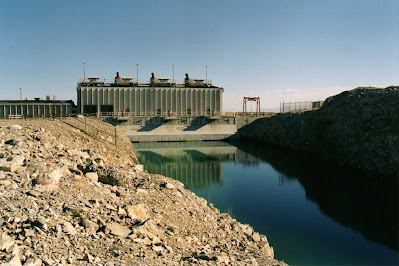 |
| A photo taken more than 10 years ago from the CLUI site. |
On the less populated, western desert side of the Great Salt Lake in Utah, not far from the rail line causeway, lies a very well maintained concrete building that has laid nearly dormant for more than 30 years. It is full of machinery, pumps, and forgotten office equipment from the 1980s to combat a threat that has since disappeared. No, it's not a relic of the cold war, but rather a water pumping station.
 |
| A picture of the construction effort from a recent KUTV news article. |
Back in the 80s, there was so much runoff from record snowfall, that the lake had seen an unprecedented rise in it's shoreline to the point it was threatening to even affect the nearby airport. The Utah leadership declared a state of emergency and allocated 60 million dollars for the project to be fast-tracked to fruition in less than a year.
Completed in 1987 by the Utah Division of Water Resources, the station ran their pumps for two years and reduced the water line of the lake by more than two feet. Then, due to a sudden lack of contributing fluid to the previously rising water level, it ceased operations in 1989.
 |
| A picture of the massive engines used inside the station, also obviously taken from the KUTV article. |
The state currently maintains the facility in a mothballed state with regular maintenance and personnel testing the engines and pumps. It currently costs about $10,000 annually to maintain the facility in the event it is needed in the future. In that event, it's estimated it may make take approximately six months and more than 2 million dollars to bring it up to full capacity and refurbish/modernize the office spaces.
As quoted by a member of the Division of Water Resources, the water level fluctuations that caused the need for the station was an increase of 20 feet in a 20-year period, and 12 of those within a 5-year period. Being that those fluctuations can happen so suddenly, it's not unlikely that the station may be needed sometime again in the future. Go ahead and also check out that brief KUTV article about it as well for more interesting info on it.
 |
| A picture of the station in it's prime. |

No comments:
Post a Comment